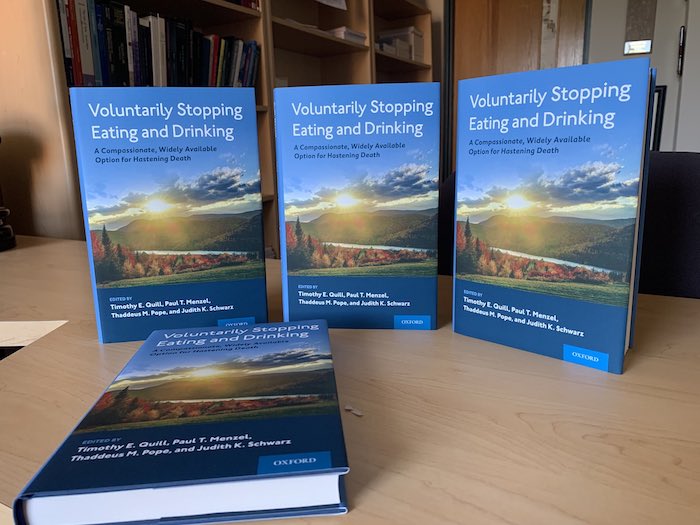— New Book Details Voluntarily Stopping Eating and Drinking

When supported by knowledgeable providers, the process can be peaceful and meaningful.
By Kelly Webster
Quality of life can diminish considerably for people living with incurable or terminal diseases. They have thoughts and questions about what the end of their life will look like. They may wonder about their condition deteriorating, losing their dignity and autonomy, and being a burden on their family members. They also worry about suffering. Sometimes, discussion turns to potentially hastening the end of their lives.
In a new book titled “Voluntarily Stopping Eating and Drinking: A Compassionate, Widely Available Option for Hastening Death,” University of Rochester Medical Center professor emeritus Tim Quill, M.D. provides realistic descriptions of what happens to a person when they consider and potentially choose VSED (voluntarily stopping eating and drinking). He addresses misconceptions of this poorly understood practice, which can cause people to inaccurately picture uncomfortable starvation and unrelieved suffering. The truth is that when undergoing VSED supported by knowledgeable and caring physicians, the process can be peaceful and meaningful.
“I have been engaged in research and discussions around medically assisted dying for many years. In New York State, physician-assisted death is not legal, but many terminally ill patients want and need help figuring out what their end-of-life options are,” said Quill. “VSED has been a legally available option in the background for some time now, but most people don’t know about it or fully understand it. We wrote this book to help physicians, patients, and families learn about the process from a clinical, legal, and ethical perspective.”
A Sense of Grief and Relief
Chapters from the book include several real patient stories including a contribution from Robert Horowitz, M.D., URMC division chief of Palliative Care. As a physician, Horowitz has extensive knowledge of end-of-life situations, including patients who have chosen VSED. However, he gained a unique perspective when his own mother who was facing a progressive illness wanted to discuss her future options.
At that point, she was in the early stages and had the capacity to make decisions, but she feared what would happen to her as the disease progressed. The last thing she wanted was to spend the rest of her days dependent, frail and lost in a nursing home. Now facing the situation as her son rather than her physician, Horowitz and his family held many powerful conversations with his mom and her physician. They ultimately agreed that when his mom decided the time was right—that living with additional losses incurred by disease progression was untenable to her—they would support her choice to die by VSED.
The term “grief and relief” appears many times throughout the chapters, because end-of-life can be distressing for both patients and families, but the assurance that a loved one will not suffer a worse fate is a blessing. Horowitz’s contribution to the book details his, his mother’s, and their family’s experience in a way that humanizes this medically and emotionally complicated situation.
Empathy is Key for Discussion
Both physicians and patients are often hesitant to bring up end-of-life planning because it is difficult to talk about, and because of legal and ethical concerns.
This book approaches the topic with a deep sense of empathy for all involved. When a patient and family begin to consider the road ahead, it’s important that they understand all options available, and receive comprehensive information to help them make fully informed decisions.
For a patient worried about their condition dragging on for months or even years, the desire to bring their lives to a meaningful end can bring closure for themselves and their families. The process of VSED usually takes approximately ten days to two weeks from initiation to death, provided the patient strictly adheres to the process. This gives the patient and family a very meaningful but finite period of time to come together, make final plans, and say farewell. For families and loved ones, the patient finally finding a peaceful escape can be a blessing.
The key for any end-of-life situation is open communication. This book can be a tool for opening up the conversation between family members, and/or for a patient to start a discussion with his or her physician. Without doubt, these conversations can be difficult. However, they can be made easier with the knowledge and compassion offered in this book.
Quill is world renowned for his progressive discussions around palliative care and end-of-life situations. In addition to his clinical role at URMC, he is also a board member of the Death with Dignity National Center in Portland, Oregon. In 2013, Quill was included on a list of “Hospice and Palliative Medicine Visionaries” by the American Academy of Hospice and Palliative Medicine.
Complete Article ↪HERE↩!
